UC Davis’ asymptomatic COVID-19 testing program completed its 1 millionth test this week, a little more than a year since the campus began offering tests to on-campus students, faculty and staff in mid-September 2020.
“Our asymptomatic testing program was the original foundation of the university’s COVID-19 strategy and, along with vaccination, continues to be central to our mitigation efforts,” said Provost and Executive Vice Chancellor Mary Croughan.
“Reaching 1 million tests is an impressive milestone,” she said, “reflecting both our seriousness in meeting this challenge and the incredible intellectual resources of our faculty. Thanks to the preventive measures our community has adopted—which also include masking, physical distancing, and other behaviors—we have kept our COVID-19 positivity rates well below those of California and the nation.”
Asymptomatic testing has been essential to controlling the spread of SARS-CoV-2 on the Davis and Sacramento campuses, as well as in the Davis community through the Healthy Davis Together initiative and in the wider community through Healthy Yolo Together. Community testing began in November 2020. The Genome Center also processes tests for K-12 schools throughout Yolo County and for UC Merced. On a typical weekday this month, the ARC testing kiosk on campus collects 4,000 samples from students and university employees.
Of 1 million tests performed so far, about 4,500 were positive. The current on-campus positivity rate is 0.06% and the rate for Healthy Yolo Together is 0.66%.
The UC Davis test was developed by a team led by Richard Michelmore, director of the Genome Center and professor of Plant Sciences. In the early days of the pandemic, Michelmore realized that the high number of PCR tests required for a comprehensive campus testing program could be carried out by machines developed for high-throughput agricultural genetics. To make taking the test easier and more accepted in repeat testing, the team developed a method to use saliva samples instead of swabbing the nasal cavity.
Media Resources
Read more about how the testing program was developed.
Healthy Davis Together: Could This Be the Future of Public Health in America?
Media Contact
- Andy Fell, News and Media Relations, 530-304-8888, ahfell@ucdavis.edu
